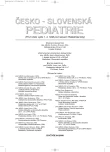Regional Difference in the Rates of Exclusively Breastfed Infants at Hospital Discharge in the Czech Republic from 2000 to 2006
Authors:
A. Mydlilová 1; A. Šípek 2; J. Wiesnerová 3; J. Vignerová 4
Authors‘ workplace:
Národní laktační centrum, Fakultní Thomayerova nemocnice, Praha
vedoucí MUDr. A. Mydlilová
1; Oddělení lékařské genetiky, Fakultní Thomyaerova nemocnice, Praha
prim. MUDr. V. Gregor
2; Ústav zdravotnických informací a statistiky ČR
ředitelka Mgr. V. Mazánková
3; Státní zdravotní ústav, Oddělení hygieny dětí a mládeže, Praha
ředitel MUDr. M. Bořek
4
Published in:
Čes-slov Pediat 2009; 64 (1): 4-11.
Category:
Original Papers
Overview
Purpose:
To identify regions (or particular hospitals) with the lowest exclusive breastfeeding rates at hospital discharge and regional changes in breastfeeding rates from 2000 to 2006 in relation to increasing number of Baby-Friendly hospitals.
Methods:
Data from 675,650 infants born from 2000 to 2006 were collected retrospectively from newborn reports and statistically analyzed.
Results:
The initial increase in the exclusive breastfeeding rate from 90.45% in 2000 to 91.32% in 2002 was followed by a decrease to 89.35% in 2006. To the worst regions with rates under 89% belonged region Karlovy Vary throughout the whole study period and in 2006 the rates decreased under 89% also in regions Ústí n./L., Prague, Olomouc and Central Bohemia. The regions of Karlovy Vary, Ústí n./L. and Prague had the highest proportion of too young (<20 years) or too old (≥35 years) mothers – groups representing risk for breastfeeding. With exception of the Olomouc region, most hospitals of all other regions with low rates are not designed Baby-Friendly. Although the breastfeeding rates were higher in Baby-Friendly (BF) hospitals in comparison with non-BF-hospitals, the difference among particular hospitals were high and in 2006 even 8 BF-hospitals had breastfeeding rates under 85%. The low breastfeeding rates were identified in large hospitals (>2000 born infants per year) with perinatal center, where high risk neonates are concentrated.
Conclusion:
In breastfeeding support it is necessary to focus on regions (or particular hospitals) with identified low breastfeeding rates. To maintain the progress of BF-hospitals the reassessment should be held every 3 years.
Key words:
breastfeeding, Baby-Friendly maternity hospital, perinatal center, maternal age
Sources
1. Müllerová D, Stožický F, Schneiderová D, et al. Výživové zvyklosti českých dětí v prvním půlroce života – zavádění příkrmů v praxi. Čes.-slov. Pediat. 2004;59(11): 561–565.
2. Mydlilová A, Šípek A, Vignerová J. Breastfeeding rates in Baby-friendly and non-Baby-friendly hospitals in the Czech Republic from 2000 to 2006. J. Hum. Lact. 2008; accepted for publication.
3. Graham K, Scott J, Binns C, et al. National targets for breastfeeding at hospital discharge have been achieved in Perth. Acta Paediatr. 2005;94: 352–356.
4. Protection, Promotion and Support of Breastfeeding in Europe: a Blueprint for Action. Dublin, 2004. http://ec.europa.eu/health/ph_projects/2002/promotion/promotion_2002_18_en.htm
5. Broadfoot M, Britten J, Tappin D, et al. The Baby Friendly Hospital Initiative and breastfeeding rates in Scotland. Arch. Dis. Child. Fetal. Neonatal. Ed. 2005;90: 114–116.
6. Kramer MS, Chalmers B, Hodnett ED, et al. Promotion of Breastfeeding Intervention Trial (PROBIT): A randomized trial in the Republic of Belarus. JAMA 2001;285: 413–420.
7. Philipp BL, Malone KL, Cimo S, et al. Sustained breastfeeding rates at a US Baby-Friendly Hospital. Pediatrics 2003;112: 234–236.
8. Weng DR, Hsu CS, Gau ML, et al. Analysis of the outcomes at babyfriendly hospitals: Appraisal in Taiwan. Kaohsiung J. Med. Sci. 2003;19: 19–28.
9. Caldeira AP, Goncalves E. Assessment of the impact of implementing the Baby friendly hospital initiative. J. Pediatr. 2007;83(2): 127–132.
10. Cattaneo A, Buzzetti R. Effect on rates of breast feeding of training for the Baby Friendly Hospital Initiative. Br. Med. J. 2001;323: 1358–1362.
11. Lyubov VA. The Breastfeeding Support and Promotion in Baby-Friendly Maternity Hospitals and Not-as-Yet Baby-Friendly Hospitals in Russia. Breastfeeding Medicine 2006;1(2): 71–78.
12. Merewood A, Mehta SD, Chamberlain LB, et al. Breastfeeding Rates in US Baby Friendly hospitals: Results of a National Survey. Pediatrics 2005;116(3): 628–634.
13. Labbok M, Wardlaw T, Blanc A, et al. Trends in exclusive breastfeeding: findings from the 1990s. J. Hum. Lact. 2006;22(3): 272–276.
14. Mydlilová A, Schneiderová D, Šípek A. Vliv některých faktorů na počet kojených dětí při propuštění z porodnice v letech 2000 až 2004. Čes.-slov. Pediat. 2008;63(4): 182–191.
Labels
Neonatology Paediatrics General practitioner for children and adolescentsArticle was published in
Czech-Slovak Pediatrics

2009 Issue 1
Most read in this issue
- Prevention of CAN Syndrome in the Child
- Anatomical, Embryological and Ethical Aspect of Conjoined (Siamese) Twins
- Recommendation for Diagnostics and Therapy of Hypertension in Children and Adolescents Elaborated by the Working Group of Pediatric Cardiology
- Development of Crohn’s Disease during the Course of HLA B27+ Juvenile Idiopathic Arthritis
